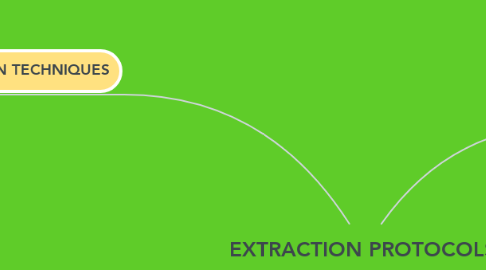EXTRACTION PROTOCOLS
by nurul jannah


1. EXTRACTION TECHNIQUES
1.1. Maceration
1.2. Infusion
1.3. Percolation
1.4. Digestion
1.5. Decoction
1.6. Soxhlet
1.7. Sonification
2. PROPERTIES OF GOOD SOLVENT IN PLANT EXTRACTION
2.1. 1. Low toxocity
2.1.1. eg: water, ethanol
2.2. 2. Easy to evaporate at low heat
2.2.1. eg: ethanol
2.3. 3. Promotion of rapid physiologic absorption of the extract
2.3.1. eg: cold water cannot extract the tea, hot water is good to extract the tea
2.4. 4. Inability to cause the extract to dissociate
2.4.1. (the solvent/ preservative not destroy the active compound)
2.5. 5. Preservative action
3. STEPS INVOLVED IN THE EXTRACTION
3.1. 1. Size reduction
3.2. 2. Extraction
3.3. 3. Filtration
3.4. 4. Concentration
3.5. 5. Drying
4. EFFECT OF EXTRACTED PLANT PHYTOCHEMICAL DEPENDS ON
4.1. 1. Nature of plant material
4.1.1. eg: root, bark, flower, fruit and more
4.2. 2. Origin
4.2.1. eg: country, forest, urban
4.3. 3. Degree of processing
4.4. 4. Moisture content
4.5. 5. Particle size
5. DEFINITION
5.1. Seperation of medicinal plant using solvent
5.2. Extract from medicinal plants to get active compounds using standard procedures
6. PURPOSE OF STANDARDIZED EXTRACTION
6.1. To attain the therapeutically desired portions
6.2. To elimate unwanted material by treatment with a selective solvent
7. PARAMETERS INFLUENCING THE QUALITY OF AN EXTRACTION
7.1. 2. Solvent used for extraction
7.2. 3. Extraction procedure
7.2.1. 1. Plant part used as starting material

